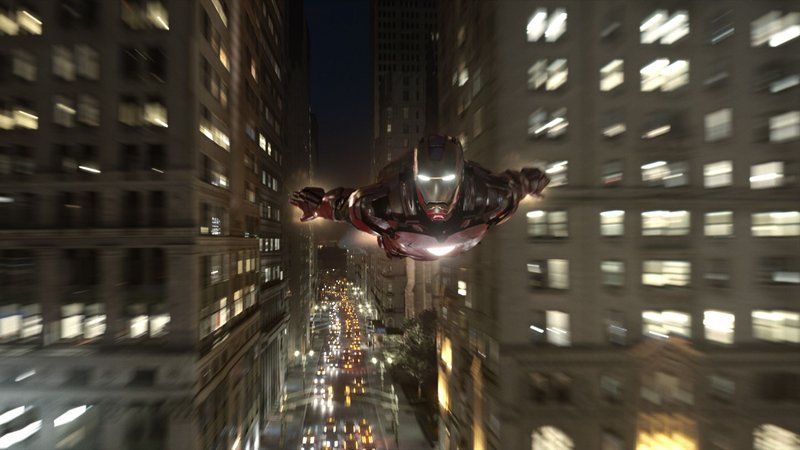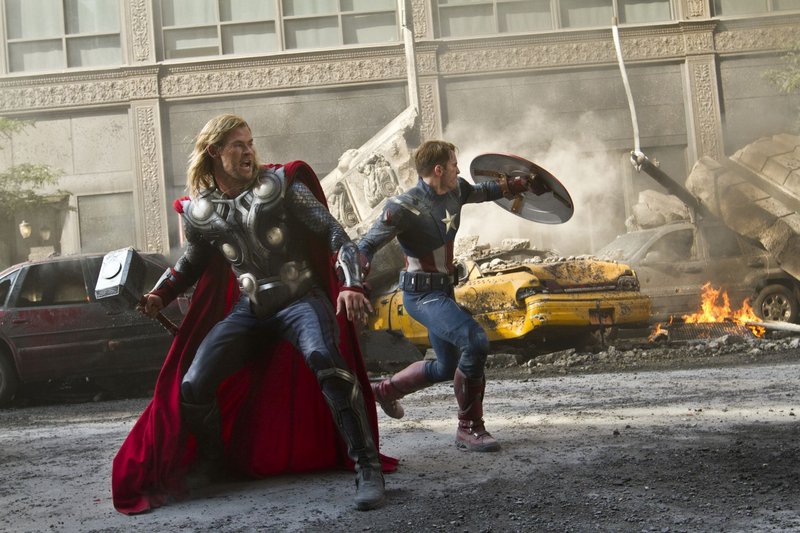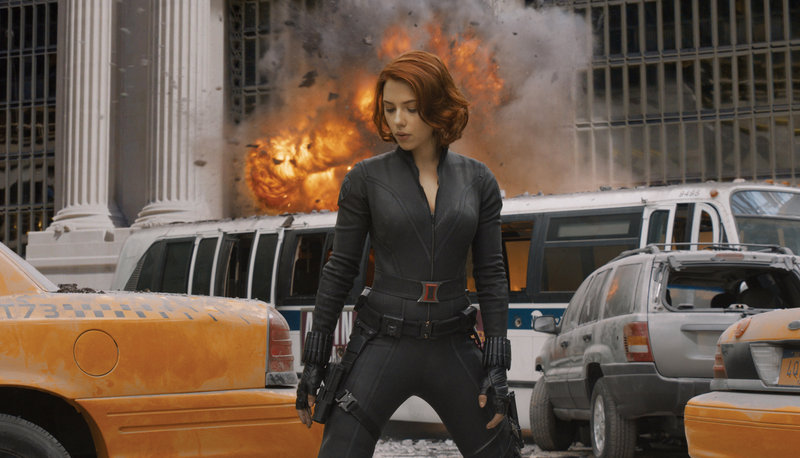The news is grim — a team member has gone down, the worst is feared — and Iron Man (Robert Downey Jr.) and Captain America (Chris Evans) exchange pensive looks while, all around them, the agents of a super-spy agency called S.H.I.E.L.D. tend to their duties as an off-planet enemy force threatens the entire planet.
The scene, being filmed on an elevated set in Albuquerque, N.M., was watched from a safe and ironic distance by Joss Whedon. “You know, you shouldn’t worry too much,” the director and co-writer of “The Avengers” reassured a visitor to the New Mexico set. “This kind of stuff happens here almost every day in the Marvel universe.”
It does feel sometimes like Hollywood has become a digital factory dedicated to cosmic dangers and costumed heroes, but “The Avengers” is a special case even in this summer when Spider-Man and Batman will also be back in action on planet popcorn.
When “The Avengers” arrives in theaters on Friday it will represent an unprecedented Hollywood experiment — can the narrative threads from four film franchises come together to form a unified tapestry in a fifth, all-star franchise? (And by throwing in a couple of newer faces, can it even launch a sixth or seventh?)
The great thrill the movie offers is a sky full of iconic characters, but the danger is that without a story that can handle their combined weight, the movie will never get off the ground.
“This is something unprecedented, and some days that makes it exciting, and then there have been days along the way where it was nerve-racking or a little scary,” said Kevin Feige, the president of Marvel Studios and the key architect of the latticework approach that connects “The Avengers” with the continuities of Iron Man, Thor, Captain America and the Hulk in their “home” franchises.
The villain (at least the one that Marvel is revealing at this point) is Loki, the conniving Asgardian played by Tom Hiddleston in “Thor” and that nods to comic-book history — that same trickster god was the catalyst that led to the super-team’s formation in the 1963 story by writer Stan Lee and artist Jack Kirby.
Lee has a cameo in the movie (as he does in most Marvel properties that reach the silver screen), and even he finds it hard to believe that Hollywood has delivered one movie jammed with gods, aliens, super-soldiers, monsters, spies and a guy with a bow and arrow.
“We used to put anything in there that we could think of because all you had to do was be able to draw it,” the 89-year-old icon said. “They could never make it a TV show or a movie because it would look ridiculous. But now they can do it with the special effects. It’s not ridiculous.”
That is the hope, at least. But Lee makes a good point. For decades the standard Hollywood approach to superhero adaptations was to ask the question, “How can we fix this comic book character and make him look like a credible movie property?” Now the question is, “How can we use digital effects to make the movie screen into a living comic book?”
“Open those old comics and look inside and what you find is modern mythology and great stories and drama and conflict and amazing places,” Feige said. “Why not look for the reasons these characters have endured instead of ‘fixing’ them?”
The Avengers (like most of the Marvel creations of the 1960s) were defined by their flaws and frustrations, and that carries over into this new silver-screen edition. Downey’s Iron Man is self-obsessed and charismatically arrogant; Evans’ Captain America is a lost soldier after decades in suspended animation; Chris Hemsworth’s Thor is badly rattled by the fact that his brother, Loki, is endangering billions; and then there’s Mark Ruffalo stepping in as Bruce Banner, who has the ultimate anger-management issue — he turns into the Hulk.
Scarlett Johansson, Samuel L. Jackson, Jeremy Renner and Cobie Smulders are among the film’s other players, and each brings a unique bundle of conflict or complication to the all-star equation.
“We’re not a team, we’re a time bomb,” Ruffalo’s frazzled scientist says at one point in the film, a line that presents a segue to the question of box-office bankability. Early audience survey data hint that the movie’s opening weekend will be explosively successful — as opposed to that other kind of Hollywood bomb.
The reviews the film gets, however, will be determined in large part by Whedon, the “Buffy the Vampire Slayer” creator who hopes “The Avengers” might finally push his resume (which includes the misfire of “Dollhouse” and the tragically unappreciated “Firefly”) to match his reputation and cult following.
Whedon, now 47, was brought in to solve the numbers problem posed by the Avengers — how can one movie hold this many heroes, armed agents and villains (there’s a surprise bad-guy who will make Marvel readers of a certain age yelp in joy) and still be more compelling than a roll call or a barrage of one-liners (a la Joel Schumacher’s “Batman & Robin”)?
Whedon is viewed as a savant when it comes to ensemble dialogue — watch group scenes in old “Firefly” episodes and hear the sly symphonies of angst, bravado, love, lust, doubt and deceit. But he was skeptical when approached in early 2010 with a screenplay by Zak Penn (“X-Men: The Last Stand”).
“They showed me a script and I said, ‘I don’t see a movie here,”‘ Whedon said last summer on the set. “I wasn’t really thinking about it as a gig. It was a gradual thing. Like quicksand. I did tell them up front that I wasn’t coming in thinking, ‘Can I get this (job)?’ The question in my head was, ‘Can this get me?”‘
“It” did get him, and Whedon says working with Feige in the unusual collaborative tandem approach that is Marvel Studios has been “one of the most enjoyable experiences I’ve ever had.” Whedon said he’s especially pleased to find the new on-screen shadings for the Banner character and to work with professionally outsized personalities such as Downey and Jackson. He says the comedy moments of the film are strong too, thanks in part to the amplified roles for Johansson and Smulders, which remedied the dialogue dead corners that turn up when there are just too many male voices.
Count Downey among Whedon’s fans: “There are new depths of discovery for our characters, there are new things in the air and they each feel more real. The guy’s my hero. He should be yours.”
Perhaps, but according to Hiddleston, Whedon might actually be more the evil-genius type — not that there’s anything wrong with that in the Marvel universe.
“He has this intermittently generous and supportive side as a director,” the British actor said of Whedon. “But I also think as an artist he has a really dark sense of humor. He kept telling me how much fun he had writing Loki. He steps inside the villains in a way that he doesn’t with the heroes.”
Send questions/comments to the editors.





Success. Please wait for the page to reload. If the page does not reload within 5 seconds, please refresh the page.
Enter your email and password to access comments.
Hi, to comment on stories you must . This profile is in addition to your subscription and website login.
Already have a commenting profile? .
Invalid username/password.
Please check your email to confirm and complete your registration.
Only subscribers are eligible to post comments. Please subscribe or login first for digital access. Here’s why.
Use the form below to reset your password. When you've submitted your account email, we will send an email with a reset code.